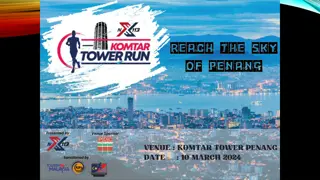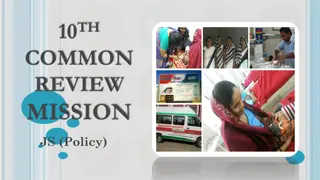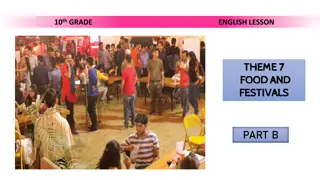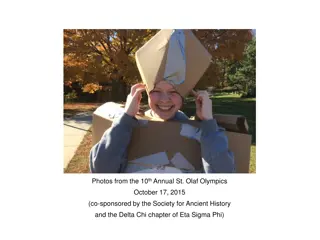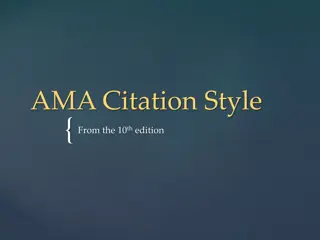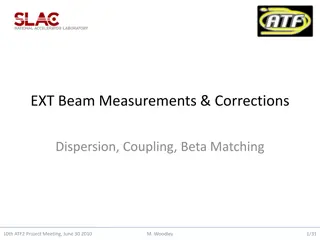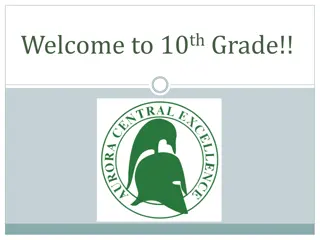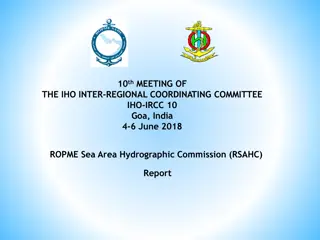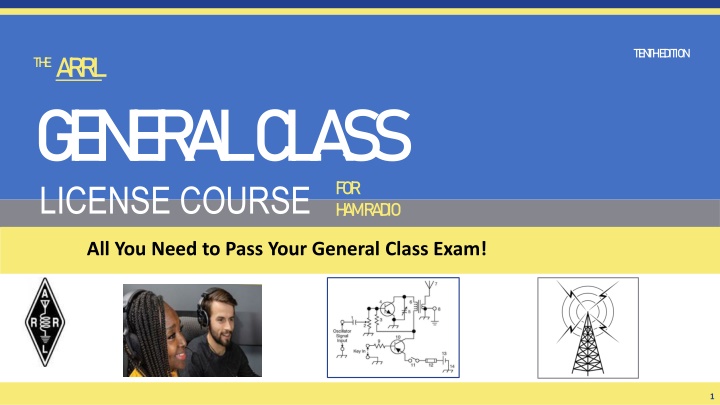
Pass Your General Class Exam with TE.N.TH.E.D.ITION - ARRL Radio Licensing Course
"Prepare for your General Class exam with TE.N.TH.E.D.ITION, a comprehensive course covering HF operating techniques, frequency selection, signal separation, and more. Enhance your skills and knowledge to succeed in obtaining your General Class license. Get valuable resources and references from ARRL's Licensing Education and Training. Find tips on selecting frequencies, operating courteously, and understanding band plans. Learn about split/dual frequency operations for effective communication on the airwaves."
Download Presentation

Please find below an Image/Link to download the presentation.
The content on the website is provided AS IS for your information and personal use only. It may not be sold, licensed, or shared on other websites without obtaining consent from the author. If you encounter any issues during the download, it is possible that the publisher has removed the file from their server.
You are allowed to download the files provided on this website for personal or commercial use, subject to the condition that they are used lawfully. All files are the property of their respective owners.
The content on the website is provided AS IS for your information and personal use only. It may not be sold, licensed, or shared on other websites without obtaining consent from the author.
E N D
Presentation Transcript
TE N TH E D ITION TH EA RRL G E N E R A L C L A SS LICENSE COURSE FOR H A M R A D IO All You Need to Pass Your General Class Exam! 1
Resource & Reference www.arrl.org/shop/Licensing-Education-and-Training 2
Chapter 2 Part 1 of 1 ARRL General Class Procedures and Practices Sections 2.1, 2.2 HF Operating Techniques, Emergency Operation 3
Section 2.1 HF Operating Techniques Technician class operators focus skills for VHF and higher bands Although 10 meters (voice) and 80, 40, and 15 meters (CW) are HF options for technicians General class operators have the advantage of using HF A General license opens up many more frequencies, modes, and activities Almost everything you know about operating courtesy and good practices from VHF and UHF can be applied to HF 4
RECOMMENDED SIGNAL SEPARATION CW: 150-500 Hz SSB: 2-3 kHz RTTY: 250-500 Hz PSK31: 150-500 Hz Selecting a Frequency Check FCC Part 97 for frequency & mode restrictions Refer to Band Plan in Chapter 1 Remember that no group or amateur has priority access to any frequency except in the case of emergency communications On HF, perfectly clear channels are rare Goal: Find a frequency that minimizes interference to adjacent stations (and, vice versa) see recommended signal separation table 5
Selecting a Frequency (cont.) Once a frequency is found, check if another station is using it Listen for 10-20 seconds ... then Voice Mode: Is this frequency in use? This is [your call]. CW/Digital Modes: QRL? DE [your call]. Frequency selection summary Confirm frequency is authorized for your license privileges Follow the band plan under normal circumstances Listen to avoid interfering with ongoing communications 6
Split / Dual Frequency Operation When a rare or interesting station is on the air with many calling stations, it s common to operate split Set transceiver to listen on one frequency and transmit on another Allows for more orderly/effective operating Doesn t work on all transceivers Referred to as a dual-VFO feature on a transceiver 7
More Info HF Operating Techniques HF equipment is designed for continuous tuning The control used for continuous tuning is called a VFO or Variable Frequency Oscillator The minimum frequency change is called step size or step rate For short-range contacts, use 80 or 40 meters Using long-distance bands for short-range contacts needlessly occupies radio spectrum space (signal will be heard over much wider range than you re using) Longer range contacts, use 30 through 10 meters 8
Band-by-Band Frequency Guide General Class License Manual, Tenth Edition, Page 2-3 9
Very Common Q Codes Memorize these! Code Meaning QRL Are you busy? / I am busy. QSO Can you communicate? / I can communicate. (Sometimes conversation ) QRP Shall I decrease transmit power? / Decrease transmit power. QRO Shall I increase transmit power? / Increase transmit power. QSL Can you receive? / Confirm received. QRM Are you bothered by non-natural noise/interference? / I am bothered QRN Are you bothered by natural noise/interference/static? / I am bothered QRV Are you ready to receive? / I am ready QRZ QRZ? (Who is calling me?) / QRZ _ _ _ _ _ (QRZ _ _ _ _ _ is calling you.) QTH What is your location? / My location is. 10
Which of the following is true concerning access to frequencies? A. Nets have priority B. QSOs in progress have priority C. Except during emergencies, no amateur station has priority access to any frequency D. Contest operations should yield to non-contest use of frequencies G2B01 (C) [97.101(b), (c)] Page 2-4 12
What is good amateur practice if propagation changes during a contact creating interference from other stations using the frequency? A. Advise the interfering stations that you are on the frequency and that you have priority B. Decrease power and continue to transmit C. Attempt to resolve the interference problem with the other stations in a mutually acceptable manner D. Switch to the opposite sideband G2B03 (C) Page 2-4 13
When selecting a CW transmitting frequency, what minimum separation from other stations should be used to minimize interference to stations on adjacent frequencies? A. 5 Hz to 50 Hz B. 150 Hz to 500 Hz C. 1 kHz to 3 kHz D. 3 kHz to 6 kHz G2B04 (B) Page 2-2 14
When selecting an SSB transmitting frequency, what minimum separation should be used to minimize interference to stations on adjacent frequencies? A. 5 Hz to 50 Hz B. 150 Hz to 500 Hz C. 2 kHz to 3 kHz D. Approximately 6 kHz G2B05 (C) Page 2-2 15
How can you avoid harmful interference on an apparently clear frequency before calling CQ on CW or phone? A. Send QRL? on CW, followed by your call sign; or, if using phone, ask if the frequency is in use, followed by your call sign B. Listen for 2 minutes before calling CQ C. Send the letter V in Morse code several times and listen for a response, or say test several times and listen for a response D. Send QSY on CW or if using phone, announce the frequency is in use, then give your call sign and listen for a response G2B06 (A) Page 2-4 16
Which of the following complies with commonly accepted amateur practice when choosing a frequency on which to initiate a call? A. Listen on the frequency for at least two minutes to be sure it is clear B. Identify your station by transmitting your call sign at least 3 times C. Follow the voluntary band plan D. All these choices are correct G2B07 (C) Page 2-2 17
What does the Q signal QRL? mean? A. Will you keep the frequency clear? B. Are you operating full break-in? or Can you operate full break-in? C. Are you listening only for a specific station? D. Are you busy? or Is this frequency in use? G2C04 (D) Page 2-4 18
Which of the following are examples of the NATO Phonetic Alphabet? A. Able, Baker, Charlie, Dog B. Adam, Boy, Charles, David C. America, Boston, Canada, Denmark D. Alpha, Bravo, Charlie, Delta G2D07 (D) Page 2-2 19
Which of the following is a common use of the dual-VFO feature on a transceiver? A. To allow transmitting on two frequencies at once B. To permit full duplex operation -- that is, transmitting and receiving at the same time C. To transmit on one frequency and listen on another D. To improve frequency accuracy by allowing variable frequency output (VFO) operation G4A12 (C) Page 2-4 20
Making Contacts Calling CQ is rare* on VHF/UHF FM channels, but the method many contacts are initiated on HF To call CQ on phone/voice CQ CQ CQ, this is [your call repeated a few times with phonetics] Example (K ILP): CQ CQ CQ, this is kilo-zero-india-lima-papa, kilo-zero-india-lima-papa Pause for a response If no response, repeat your CQ To call CQ on CW CQ CQ CQ DE [your call withoutphonetics] * Calling CQ is rare on VHF/UHF, but acceptable to use. 21
Making Contacts, CQ Variations CQ DX (DX means distant stations) If you hear CQ DX from a station on the US mainland, it means the person calling is looking for stations outside the lower 48 states On HF, it generally refers to any station outside the caller s country During CQ contests, you ll generally hear CQ Contest , CQ test , or CQ from special event station CQ for stations from certain areas CQ North America or CQ California 22
Joining an Ongoing QSO (Contact) Joining a QSO (also called breaking in) is common On phone/voice, just say your call sign On CW / digital modes, send BK (break) followed by your call sign Same rules apply during contests and competitive events 23
DX Windows Originally designed to give operators from countries with restricted privileges band space to make DX contacts outside their countries Only a few kHz wide on some bands Now less common with increasing world-wide frequency allocations but 50.1 to 50.125 MHz is the place to listen for long-distance contacts outside the contiguous 48 states 24
Nets & Schedules There are many on-the-air activities scheduled in advance Although no individual has exclusive access to frequencies, we should be courteous and accommodating Avoid scheduling contacts on national calling frequencies and popular bands Check contesting calendars on ARRL.org and other sites If you re net control and discover the net s chosen frequency to be occupied, find a nearby clear frequency or change to the net s backup frequency 25
Logging Contacts No longer required, but most amateurs keep a log to verify contacts for awards and to record items of interest see NOTE below Typical log: time, date, frequency or band, mode of the contact (USB, PSK, etc.), call sign, signal reports, names, and equipment used Establishes identify of control operator and can be useful in providing info requested by the FCC NOTE: When operating on 60 meters with an antenna other than a dipole, FCC requires you to keep a record of antenna gain calculations or manufacturer s data (ensures meeting 100 W ERP restrictions). 26
Managing Interference Interference is going to occur on HF Frequencies aren t channelized There are many amateurs using the frequencies Occurs due to crowding, propagation, personal choice, atmospheric conditions, and consumer electronics Learning how to make contacts under these conditions is part of becoming a good operator 27
Types of Interference Harmful Defined by FCC 97.3(a)(23) as interference which seriously degrades, obstructs or repeatedly interrupts a radio communication service operating in accordance with the Radio Regulations It s not always illegal, but needs to be resolved to keep communicating Malicious, deliberate or willful Specifically forbidden by FCC 97.101(d) 28
Avoiding Interference Learn what bands are crowded and when Learn characteristics of each band (propagation & noise) Learn how to use your equipment (understand strengths & weaknesses) Check published calendars for major operating events 29
Reacting to Interference Be flexible no one has a claim to any frequency Have a back-up plan (especially for scheduled events nets, etc.) Do this in advance! Keep a cool head don t allow harmful interference to turn into deliberate interference! 30
Which of the following is required by the FCC rules when operating in the 60-meter band? A. If you are using an antenna other than a dipole, you must keep a record of the gain of your antenna B. You must keep a record of the date, time, frequency, power level, and stations worked C. You must keep a record of all third-party traffic D. You must keep a record of the manufacturer of your equipment and the antenna used G1C04 (A) [97.303(i)] Page 2-7 32
What is the recommended way to break in to a phone contact? A. Say QRZ several times, followed by your call sign B. Say your call sign once C. Say Breaker Breaker D. Say CQ followed by the call sign of either station G2A08 (B) Page 2-6 33
Generally, who should respond to a station in the contiguous 48 states calling CQ DX ? A. Any caller is welcome to respond B. Only stations in Germany C. Any stations outside the lower 48 states D. Only contest stations G2A11 (C) Page 2-5 34
What is the voluntary band plan restriction for US stations transmitting within the 48 contiguous states in the 50.1 MHz to 50.125 MHz band segment? A. Only contacts with stations not within the 48 contiguous states B. Only contacts with other stations within the 48 contiguous states C. Only digital contacts D. Only SSTV contacts G2B08 (A) Page 2-6 35
Which of the following is good amateur practice for net management? A. Always use multiple sets of phonetics during check-in B. Have a backup frequency in case of interference or poor conditions C. Transmit the full net roster at the beginning of every session D. All these choices are correct G2B10 (B) Page 2-7 36
Which of the following indicates that you are looking for an HF contact with any station? A. Sign your call sign once, followed by the words listening for a call -- if no answer, change frequency and repeat B. Say QTC followed by this is and your call sign -- if no answer, change frequency and repeat C. Repeat CQ a few times, followed by this is, then your call sign a few times, then pause to listen, repeat as necessary D. Transmit an unmodulated carried for approximately 10 seconds, followed by this is and your call sign, and pause to listen -- repeat as necessary G2D05 (C) Page 2-5 37
Why do many amateurs keep a station log? A. The FCC requires a log of all international contacts B. The FCC requires a log of all international third-party traffic C. The log provides evidence of operation needed to renew a license without retest D. To help with a reply if the FCC requests information about your station G2D08 (D) Page 2-7 38
Which of the following is required when participating in a contest on HF frequencies? A. Submit a log to the contest sponsor B. Send a QSL card to the stations worked, or QSL via Logbook of The World C. Identify your station per normal FCC regulations D. All these choices are correct G2D09 (C) Page 2-6 39
Modes Amateurs use many different modes of communication. The invention of these various modes is a example of amateur radio fulfilling its mission to contribute to the state of the radio art. (per Part 97.1b) CW (continuous wave) found in lower ranges for each HF band. However, CW operation is permitted throughout all amateur bands. AM & SSB (single-side band) SSB is the most common voice mode or phone signal Has displaced AM as the preferred HF voice modulation method SSB signals use less spectrum space than AM (3 kHz vs. 6 kHz this increases efficiency results in SSB having a greater range than AM 40
Modes (cont.) USB vs. LSB (upper and lower side band) Good amateur practices is to use USB above 9 MHz (20 thru 10 meters) and LSB elsewhere except on 60 meters USB is used on VHF and UHF FM is generally not used on HF because higher noise hurts intelligibility Exception: FM repeaters can be found on the higher frequencies of 10 meters (above 29 MHz) where cross-continent and DX contacts can be made when the band is open 41
Modes (cont.) Digital Voice Relatively new on HF bands Operator s voice converted to and from a digital stream via modem or sound card. Modem connects to a regular SSB transceiver. Fidelity comparable to regular SSB signals, but less affected by fading Most popular digital voice modes: FreeDV and protocol developed by G4GUO (Charles Brain) 42
Modes (cont.) Digital Modes Packet radio common on VHF and UHF to exchange digital data, but also common on HF FT8: Most popular FT8, PSK63 and PSK31: Effective at low power levels all widely used RTTY: Oldest, and still common (radioteletype) PACTOR or WINMOR: Used for semi-automatic and automatic messaging for small files More info on digital modes in Chapter 6 43
Modes (cont.) Image Modes Image mode transmissions on HF encode photos & graphics to tones These tones are reconstructed as an image on a display Allowed on same frequencies as voice, except for 60 meters Most common image mode: Slow-scan television (SSTV) Called slow because each image takes several seconds Fast-scan amateur television (ATV) allows full motion video Restricted to 432 MHz and higher frequency bands (due to wide bandwidth) 44
Mode Comparison More details in Chapters 5 & 6 45
Which mode is most commonly used for voice communications on frequencies of 14 MHz or higher? A. Upper sideband B. Lower sideband C. Suppressed sideband D. Double sideband G2A01 (A) Page 2-10 47
Which mode is most commonly used for voice communications on the 160-, 75-, and 40-meter bands? A. Upper sideband B. Lower sideband C. Suppressed sideband D. Double sideband G2A02 (B) Page 2-10 48
Which mode is most commonly used for SSB voice communications in the VHF and UHF bands? A. Upper sideband B. Lower sideband C. Suppressed sideband D. Double sideband G2A03 (A) Page 2-10 49
Which mode is most commonly used for voice communications on the 17- and 12-meter bands? A. Upper sideband B. Lower sideband C. Suppressed sideband D. Double sideband G2A04 (A) Page 2-10 50




